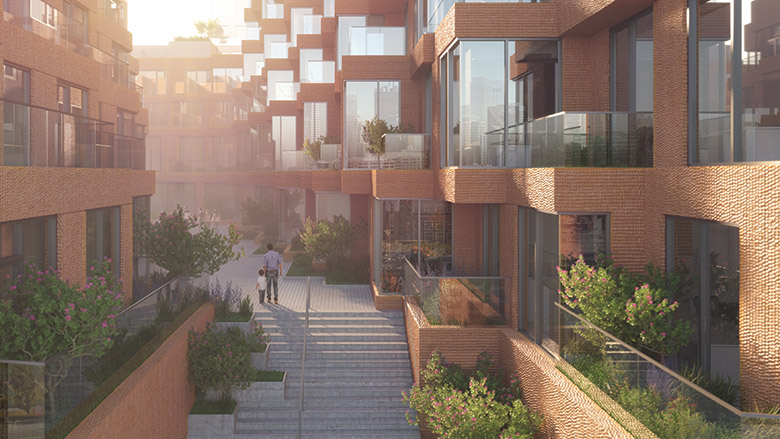The CHIPS and Science Act aims to bolster U.S. leadership in innovation and technology. For some Top 100 sustainable design firms like Flad Architects, it’s an opportunity to expand into science and technology markets.
“Most clients now have some sustainability expectations, even before this new legislation,” says Kimberly Reddin, director of sustainability. However, “the expanded commercial building energy efficiency deduction provides additional financial incentives for clients,” she says. The incentives could increase the appetite for owners to implement energy savings measures.
Related Links:
ENR 2022 Top 100 Green Buildings Design Firms
ENR 2022 Top 100 Green Building Contractors
View complete 2022 list, with full market analysis
(Subscription Required)
“The funding to update energy codes could codify those energy savings measures in some jurisdictions,” Reddin explains. Additionally, the Inflation Recovery Act’s (IRA) investment in Dept. of Energy lab infrastructure could also potentially present some opportunities at national labs, she says. “There truly are a lot of provisions that could have an impact on our sustainability business, but the passage of this legislation may also increase sustainability business by changing the national mindset.”
One reported goal for the laws is to jumpstart the nation’s progress toward clean energy and debarbonization to a point of no return. “Once the nation is on that path, it will be difficult to turn back,” says Reddin, explaining that the federal laws targeting climate change will incentivize the production of renewable energy.
Climate-focused legislation will help initiate big picture conversations beyond projects, says Scott Beckman, director of sustainability at PCL Construction.
An interesting piece of the IRA legislation includes the Environmental Justice Mapping and Data Collection Act of 2021, Beckman explains. “Data on communities impacted by environmental harm and how that manifests in public health can direct responsible project development,” he says.
The industry-wide challenge facing any sustainability incentives will be “finding enough skilled labor to complete such a high volume of work in a tight labor market,” says Beckman.
Gilbane’s environmental solutions executive, Mark A. Winslow, sees portions of the three recently enacted bills as “all having a positive impact” in the construction industry and at a local community level.
“We see the new tax credits and funding as fostering the development of new projects,” says Winslow. Gilbane is already seeing growth in its semiconductor business arm.
“We also see the Buy America bonus within the Inflation Reduction Act as another stimulus for workforce development and local communities,” says Winslow. Buy America will encourage the expansion of U.S.-based manufacturing and additional growth within the construction sector, he says.
For Top 100 contractors, green contracting revenue in both the telecommunications and industrial process/manufacturing markets are up 69.79% and 36.74%, respectively, from 2020. Both markets have been growing steadily over the past five years. The telecommunications market made up 3.3% of green contracting revenue in 2018. That number has risen to 9.2% in 2021. Industrial process/manufacturing has risen to 4.1% from 1.3%.
Overall, “we see these new laws as conversation opportunities with clients looking to advance their sustainability efforts that were previously uncertain about funding sources,” says Winslow. “The new incentives can be looked upon as a deciding factor for moving forward with more sustainability initiatives.”
Third-party rating systems such as LEED remain a popular industry-wide tool because the review and verification process “removes greenwashing and provides legitimacy to publicized information,” says Mortenson’s Laue. But recent efforts by certifications such as the Living Building Challenge and the Living Future Institute to remove their point systems have enabled owners to focus on which areas of sustainability work best for a project, she explains.
“By moving beyond LEED certification, these other certifications have taken on a more individualized rating system that allows our customers and owners to focus on components or project types within the realm of sustainability,” adds Laue. With Mortenson’s customers, they are solving for ways to improve the occupant experience while pushing new, innovative design and building solutions that combat climate change within their scope.
“Having multiple rating system options allows us to help our customers get creative in achieving their sustainability goals and focus on what is most important to them,” she says. “All standards and rating systems need to continue to evolve and push suitability boundaries.”
Following the LEED
LEED is also gearing up to evolve with its next version after 4.1. “I think the whole theory of LEED is that we want to transform the market so we get a system out there of best practices,” says Elizabeth Beardsley, senior policy counsel at USGBC. The organization has been busy doing a lot of outreach and convening around the future of LEED as it plans to make adjustments to its rating system.
“You can expect more on climate, incorporating some of the strategies that have emerged like reducing the carbon intensity and demand of the building on a grid,” she says. Embodied carbon has also increasingly become a topic of discussion.
“These are all strategies that we’ve had in LEED before in 4.1, but they will have to be more emphasized,” says Beardsley. “There’s a lot under consideration. I think we are going to take what we’ve learned from having those credits out there and try to make that more of a core part of the system.”
Last year, there were 10 states leading LEED project certifications: Illinois, Washington, Colorado, Massachusetts, Virginia, California, Maryland, Oregon, Utah and Nevada. Washington, D.C., was also a high performer, according to the USGBC. Overall, they all accounted for 1,002 LEED certified projects, representing around 226.89 million in gross sq ft of building space.
Although the driving forces behind LEED adoption vary from state to state, Beardsley says that general market awareness, ESG and corporate sustainability initiatives and policy incentives are all driving some form of sustainability adoption at state and local levels. The top LEED certification states “all have some mix of different policies, but they all don’t have equivalently linked policies,” she explains. “Some have requirements and strong code” while others consider the market “the primary actor.”
Early on, D.C. adopted a LEED requirement for new federal and private building projects meeting certain thresholds, which has set forth an expectation to certify green buildings in the district, says Beardsley. In Nevada, a tax credit for buildings aiming for LEED certification has helped set the stage for market expansion.
Beardsley adds that the recently proposed SEC climate risk disclosures rule, which would make public a registrant’s GHG emissions, is also applying pressure among companies to clean up their building operations.
“Whatever happens with that proposal, it has certainly brought a lot of attention across the building sector and real estate on what kind of reporting is being done,” she says. “There is this heightened awareness of buildings as part of a company’s climate footprint and how a company wants to position itself.”
An update to the tax code’s 179D commercial energy efficient building property reduction will also reward buildings that improve their energy intensity by 25% or better, says Beardsley.
“Certainly, clients appreciate the increase of 179D tax credits for high performance and renewable energy design found in IRA,” says Stantec sustainability leader Beth Tomlinson. Additionally, the EPA’s Greenhouse Gas Reduction Fund provides “much needed clean energy financing for our nonprofits, state and institution clients,” she says.

AECOM (No. 1) is main contractor for JP Morgan Chase’s planned all-electric global headquarters at 270 Park in New York City. Designer Foster + Partners says the building will accommodate up to 14,000 occupants as the largest skyscraper in the city with net-zero operational emissions, powered 100% by renewable energy from a New York State hydroelectric plant.
Image courtesy of JP Morgan
Regardless of whether companies take advantage of incentives, recent laws are “upping the bar” for sustainability. She points to incentives in the Bipartisan Infrastructure Law for infrastructure projects pursuing LEED and in the IRA for green building retrofits of federal buildings.
“Those are some federal drivers, but federal buildings are a big market for the building sector,” she says. “And then some of the more private incentives are in the more recently passed IRA.”
For Caddell, which counts federal construction as a major part of its business, third-party guiding principle validation has even gained traction in the Dept. of Defense “as they prioritize sustainable structures,” says Francis G. Hernández, senior design and build coordinator for the company.
According to a Biden administration Executive Order signed last year, new federal buildings must meet the High Performance Sustainability Building (HPSB) Guiding Principles, which is not as cumbersome as meeting LEED standards, says Hernández.
“This measure of sustainability appears to have more flexibility and directly addresses the requirements in the Executive Order through validating the sustainable Guiding Principles,” he explains. The third parties providing the HPSB services include the USGBC and Green Building Initiative (Green Globes) along with private firms.
Shifting Sustainable Standards
For many Top 100 firms, rating systems have also enabled owners to think about materials used in the occupant space. “Third-party ratings systems, like the WELL Building Standard and Fitwel, have helped to drive interest in healthy, high-performing spaces that take into consideration the products used on the project, natural light, air quality, as well as operational measures like water filtration, healthy snacks and biophilic design,” says Patty Lloyd, director of sustainability at Leopardo Companies. “Now other rating systems have integrated health and wellness considerations into their offerings,” which helps owners meet more of their sustainability goals.
In addition to WELL standards, the Fitwel commercial building rating system has continued to gain popularity in the green building market.
“We have seen increased adoptions across the board,” says Sara Karerat, director of applied research for the Center for Active Design (CfAD). The certification now has project administrators and representation in all 50 states, she said, with California, New York and Texas being the highest performers.
The enthusiasm for Fitwel was already growing, but recent laws “make it a priority for the real estate community on a national scale,” says Karerat. “So that’s something that we anticipate the impact to really pick up Fitwel.”







Post a comment to this article
Report Abusive Comment